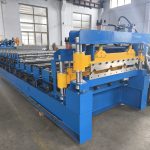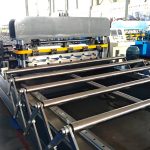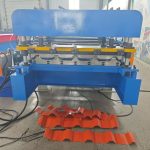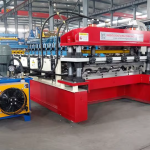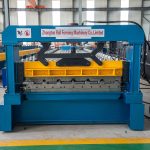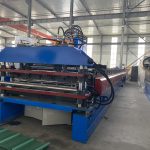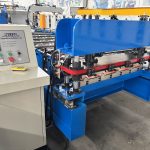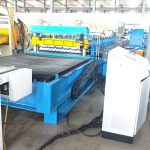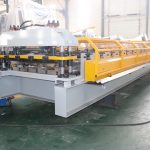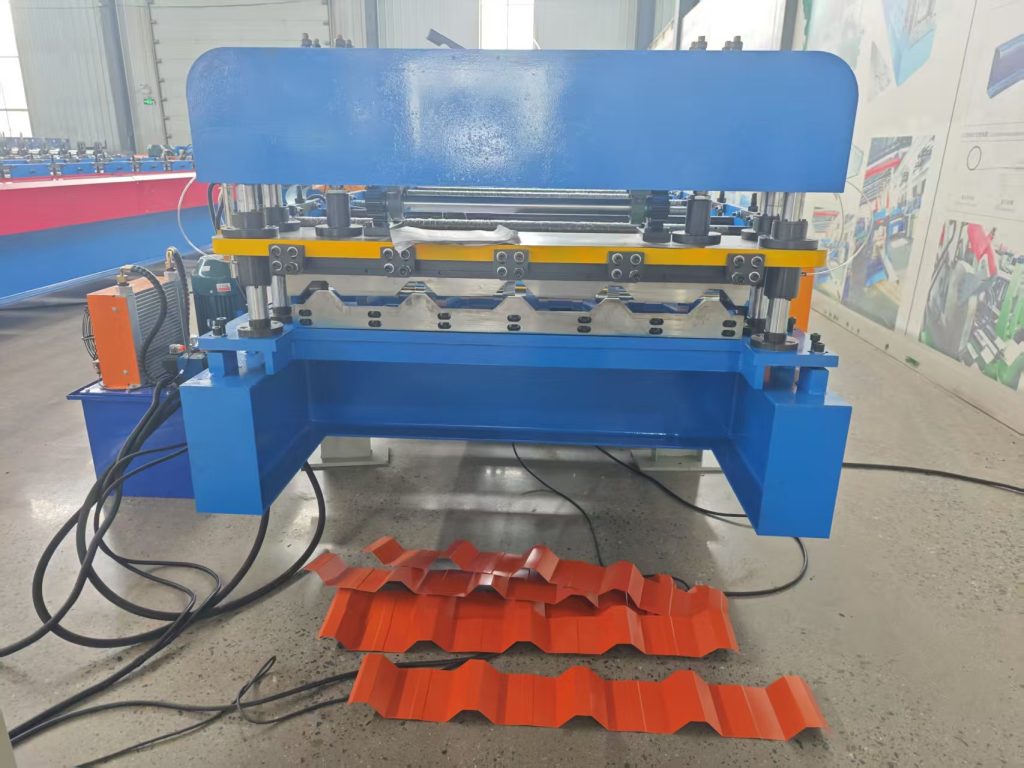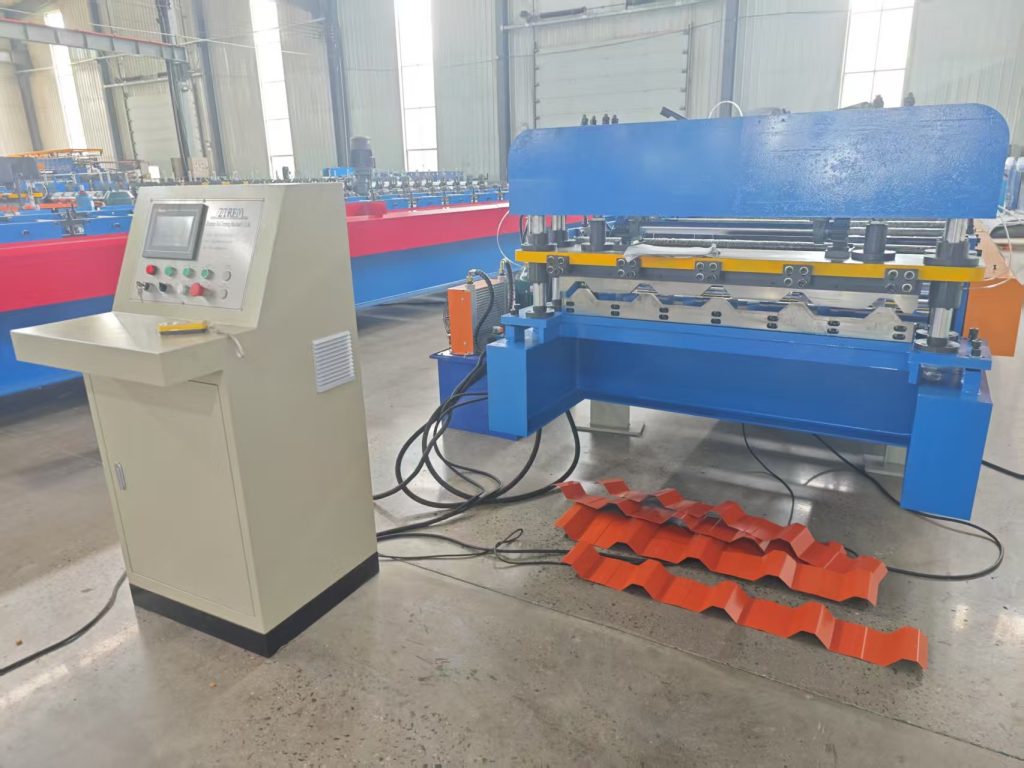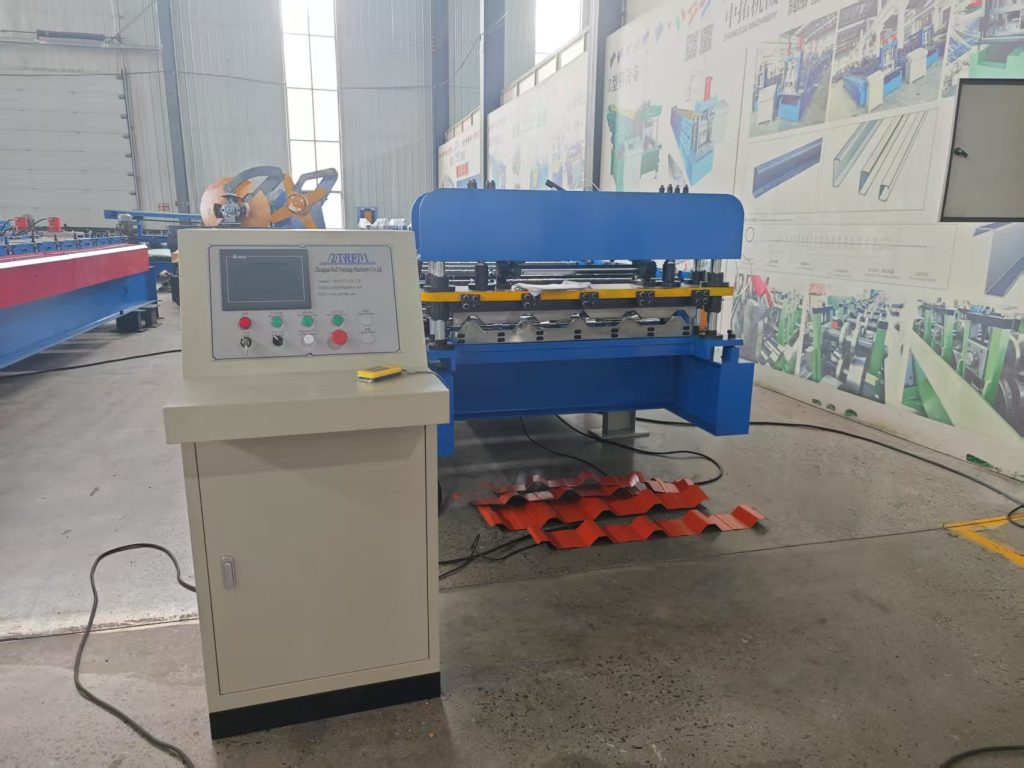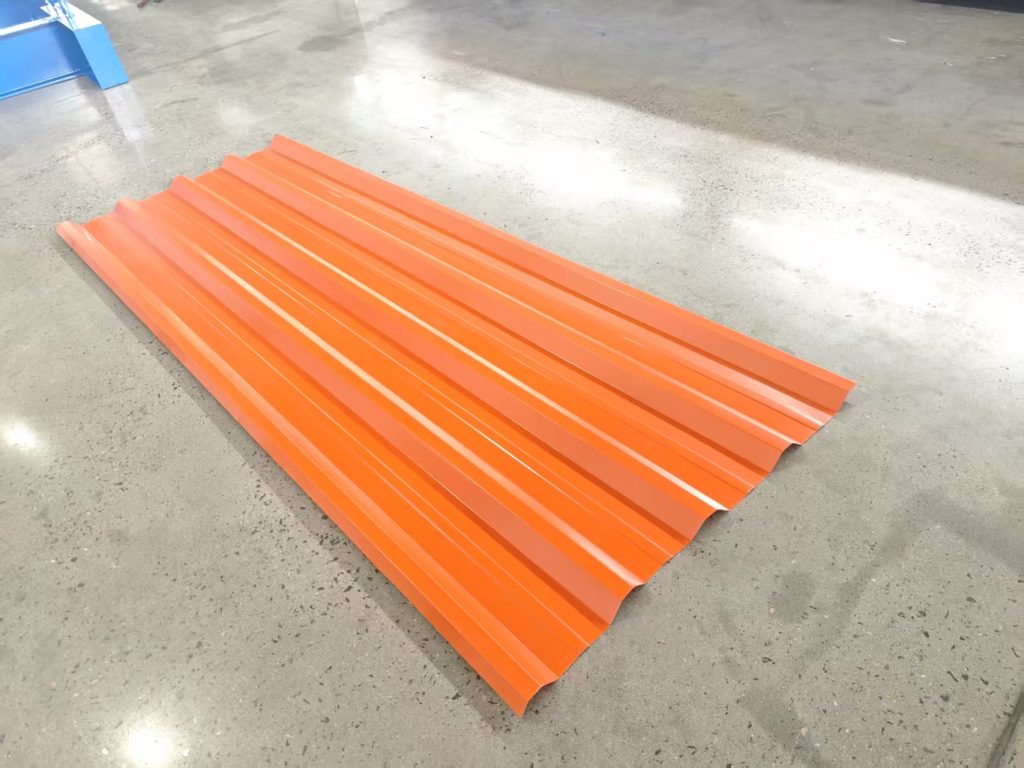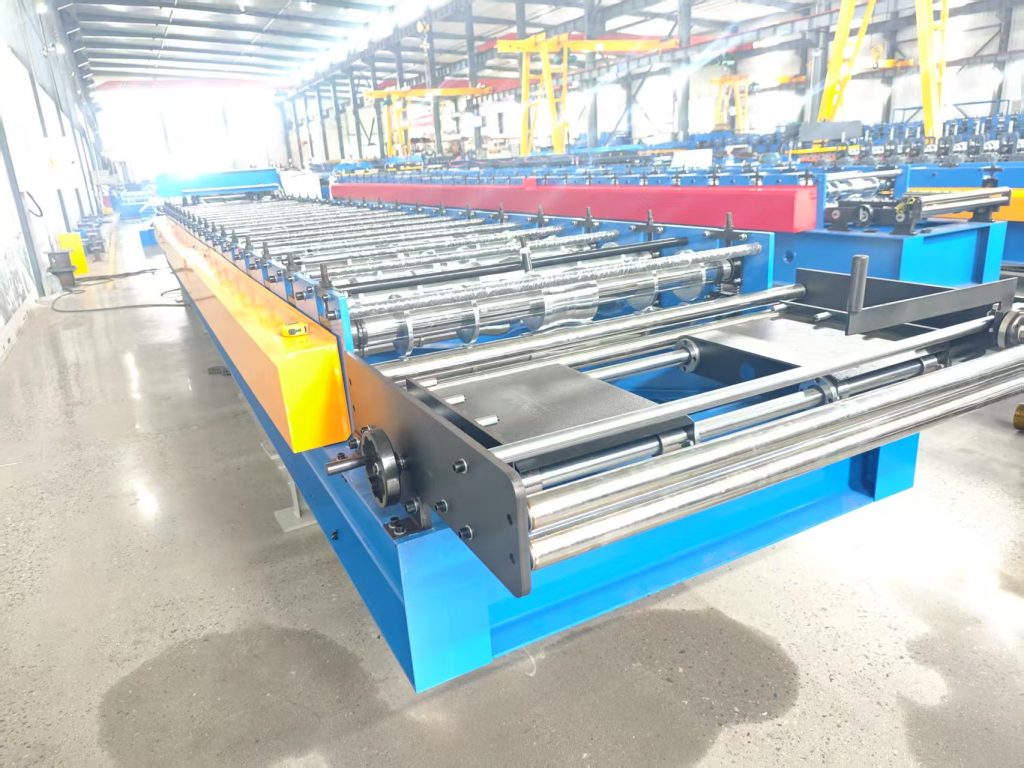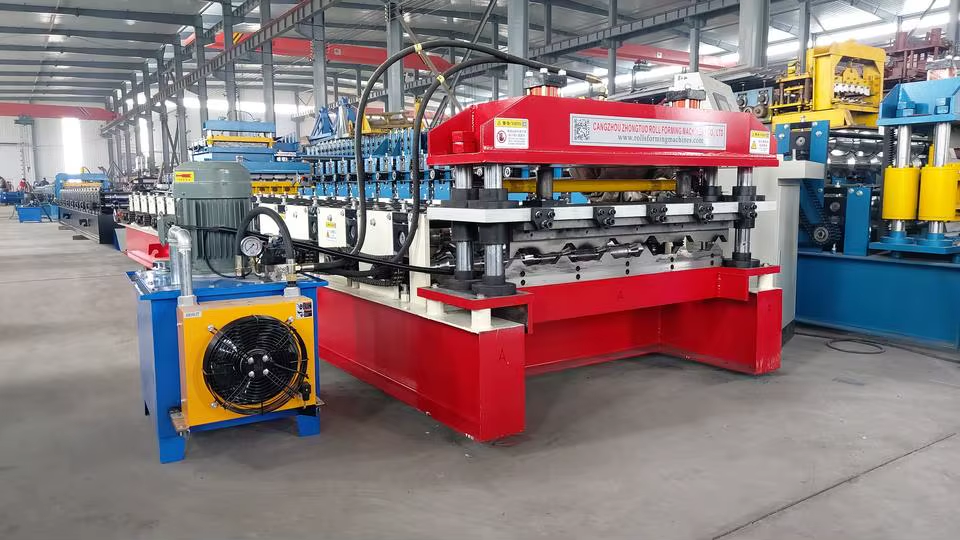https://www.youtube.com/watch?v=gK90m6jgeEo&pp=0gcJCbIJAYcqIYzv
Trapezoidal Metal Roof Sheet Roll Forming Machine With PLC Control System
As a pivotal device in the construction and building materials sector, the trapezoidal tile forming machine is tailored for metal roof tile production. It converts flat metal sheets into high-strength tiles with a trapezoidal cross-section by means of precision roll forming technology, serving as a critical tool to realize efficient and standardized construction of modern lightweight steel structure roofs. It finds applications in industrial, agricultural, civil and other fields, with its core strengths being the balance between production efficiency and product quality, as well as meeting the requirements of different buildings for the structural strength, appearance and installation adaptability of roof tiles.
I. Core Working Principle: Realizing Automated Forming in Four Stages
The production process of the trapezoidal tile forming machine follows the sequence of “raw material pretreatment – gradual forming – precise cutting – finished product output”, and the whole process relies on the coordination of mechanical transmission and electronic control systems. Specifically, it can be divided into four core stages:
1. Raw Material Pretreatment Stage
Firstly, coiled (commonly used, with lengths up to several hundred meters) or sheeted metal raw materials (such as color-coated steel sheets, galvanized steel sheets and aluminum sheets) are fed into the equipment. Then, they pass through a leveling mechanism (composed of multiple sets of leveling rolls) to eliminate wrinkles and bends generated during transportation and storage, ensuring the flatness of the sheets. Some high-end models are also equipped with derusting/cleaning devices to remove loose rust or oil stains on the sheet surface, so as to avoid affecting the subsequent forming quality and the service life of the tiles.
2. Roll Forming Stage (Core Link)
The flattened sheets enter the forming main machine, which is equipped with 10-20 sets (the number varies according to the complexity of the tile shape) of precision upper and lower opposite forming rolls. These rolls are designed in accordance with the preset cross-sectional curve of the trapezoidal tile. When the sheets pass through, each set of rolls exerts “micro-extrusion deformation” on them, gradually pressing the flat sheets into trapezoidal wave crests, wave troughs and side ribs (to enhance structural strength), and finally forming a complete trapezoidal cross-section with accurate dimensions. During this process, a servo motor precisely controls the rotation speed of the rolls to ensure a uniform sheet feeding speed, preventing forming misalignment or cracking.
3. Punching/Engraving Stage (Optional)
For trapezoidal tiles that need drainage holes, fixing holes or decorative patterns, some models add a CNC punching/engraving module after forming. According to the preset program, it can punch circular or square holes (for installing bolts or drainage) at the designated positions of the tiles, or press simple patterns (to improve the aesthetic appearance), so as to adapt to the functional and decorative needs of different buildings.
4. Fixed-Length Cutting and Finished Product Output Stage
The continuously formed tiles enter the cutting system, which uses a photoelectric sensor to detect the feeding length of the tiles. When the preset size (e.g., 1.5m, 3m, etc., which can be adjusted in real time through the control panel) is reached, a hydraulic shear or flying saw device will quickly cut the tiles. Among them, “flying saw cutting” can cut the tiles without stopping the machine, greatly improving the production efficiency (10-30 pieces can be cut per minute, depending on the tile length). Finally, the cut finished trapezoidal tiles are transported to the stacking rack through the conveyor roller table, completing the entire production cycle.
II. Core Composition of the Equipment: Five Systems Ensuring Stable Operation
The performance of the trapezoidal tile forming machine depends on the coordination of various core systems. Each system undertakes different functions and jointly determines the production efficiency, forming precision and service life of the equipment:
– Machine Frame: It is welded with heavy-duty steel structures and undergoes aging treatment to eliminate internal stress. This ensures the machine body has high rigidity and good seismic performance, and prevents the decline of forming precision due to vibration during long-term operation.
– Forming Roll Set: As a core component, it is made of 40Cr alloy steel or bearing steel, and processed through quenching (the hardness can reach HRC55-60) and chrome plating. It has a smooth and wear-resistant surface, which can accurately transmit pressure and ensure the consistency of tile shapes. The distance between the rolls can be fine-tuned through a lead screw to adapt to metal sheets of different thicknesses (0.3-1.2mm).
– Transmission System: Composed of a servo motor, a reducer and a chain/synchronous belt, it has high transmission efficiency and low noise. It can realize stepless adjustment of the feeding speed within the range of 0-30m/min to meet different output requirements.
– Electronic Control System: It adopts PLC (Programmable Logic Controller) + touch screen control, which can preset parameters such as tile length, output and cutting method. Some high-end models support remote monitoring and fault alarm, featuring convenient operation and high intelligence.
– Cutting System: There are two types: hydraulic shear (suitable for low-speed operation and thick sheets) and flying saw (suitable for high-speed operation and thin sheets). The cutting blades/saw blades are made of high-speed steel, with a cutting precision of ±1mm, avoiding tile edge deformation or burrs.
III. Main Performance Features: Balancing Efficiency, Precision and Versatility
With its advantages in technical design, the trapezoidal tile forming machine demonstrates four core features in practical application, which can meet the production needs of enterprises of different scales:
1. High Efficiency and Automation, Reducing Costs and Improving Efficiency
The whole process from raw material feeding to finished product stacking can be fully automated, and only 1-2 personnel are needed to monitor the equipment operation. The production speed can reach 5-30m/min (adjusted according to the complexity of the tile shape), with a daily output (8 hours) of 2,000-8,000㎡. Compared with traditional manual processing, the efficiency is increased by more than 50 times, significantly reducing labor costs and production cycles.
2. High Forming Precision and Stable Quality
Relying on the precision roll set and servo electronic control system, the dimensional error of the tile’s wave height, wave spacing and trapezoidal side length can be controlled within ±0.5mm. Each tile has a uniform shape and thickness, avoiding installation difficulties caused by dimensional deviations. At the same time, the roll forming process can enhance the bending resistance of the metal sheet (increased by 30%-50% compared with the flat sheet), making the trapezoidal tile have better wind resistance, pressure resistance and snow load resistance.
3. Strong Versatility and Flexible Adaptability
By replacing the forming roll set (which can be completed within 1-2 hours) and adjusting the electronic control parameters, the machine can produce trapezoidal tiles of various specifications (e.g., wave height: 20-50mm, wave spacing: 100-300mm), and adapt to raw materials of different materials such as color-coated steel sheets, galvanized sheets, aluminum sheets and stainless steel sheets. Some models also support the switching between “trapezoidal tiles and other tile types” (e.g., glazed tiles, colored stone tiles) to meet the diverse order needs of customers.
4. Good Durability and Convenient Maintenance
Key components such as the machine frame and forming roll are made of wear-resistant and corrosion-resistant materials. Under normal use, the service life of the forming roll can reach 3-5 years (the processed sheet volume is about 500,000-1,000,000㎡). The vulnerable parts of the equipment (such as cutting blades and bearings) are easy to replace, and most models are equipped with a “fault self-diagnosis function”, which can quickly locate the fault points of the motor, hydraulic system, etc., reducing the maintenance downtime.
Finished product display
IV. Application Scenarios and Product Advantages: Covering the Construction Needs of Multiple Fields
The trapezoidal tiles produced by the trapezoidal tile forming machine are widely used in various construction scenarios due to their high structural strength, convenient installation and high cost-effectiveness. The specific applications are as follows:
1. Main Application Fields
– Industrial Construction: It is used for the roof and wall enclosure of industrial plants, warehouses, logistics centers and production workshops. The trapezoidal tile has large-span adaptability (the length of a single sheet can reach 6m) and corrosion resistance (color-coated sheet/galvanized sheet material), which can meet the durability requirements of the industrial environment.
– Agricultural Construction: It is used for the roof construction of agricultural greenhouses, livestock and poultry farms and grain storage sheds. The trapezoidal tile has waterproof performance (the trapezoidal cross-section can realize rapid drainage) and light weight (about 5-10kg/㎡), which can reduce the load pressure of the greenhouse frame, and the installation cycle is short.
– Civil and Public Construction: It is used for the roof covering of rural self-built houses, prefabricated houses, temporary office buildings and scenic area supporting buildings. Some colored trapezoidal tiles (such as color-coated sheets imitating wood grain and stone grain) have both practicality and decorativeness, and can adapt to different architectural styles.
– Special Scenarios: It is applicable to buildings in coastal areas and high-humidity areas (using corrosion-resistant aluminum sheets or stainless steel sheet trapezoidal tiles), as well as areas with high seismic requirements (the flexible structure of trapezoidal tiles can adapt to slight vibrations).
2. Advantages of Trapezoidal Tile Products (Enabled by Equipment)
– Stable Structure: The trapezoidal cross-section can distribute the roof load, and its wind resistance and snow load resistance are better than those of ordinary flat tiles, making it suitable for windy and snowy areas.
– Efficient Installation: The sides of the tiles are designed with overlapping grooves, which can be directly engaged and spliced during installation without additional gluing and sealing. A single worker can install 100-150㎡ per working day, significantly shortening the construction period.
– Economic Cost: The raw materials are mainly thin metal sheets. Compared with traditional ceramic tiles and cement tiles, they are light in weight (reducing the building load cost) and low in transportation cost. In addition, their service life can reach 15-25 years, with high long-term cost-effectiveness.
Recommend related machine


